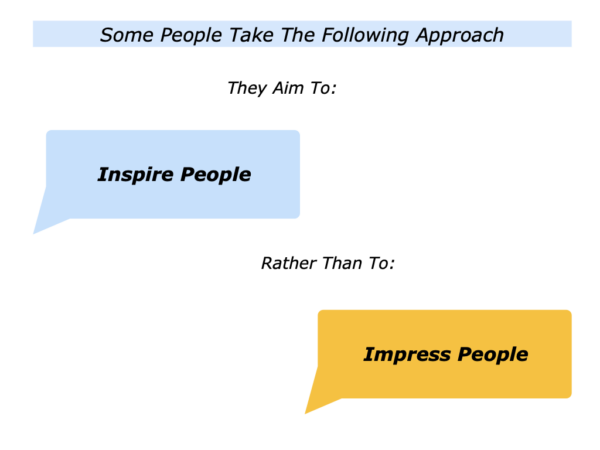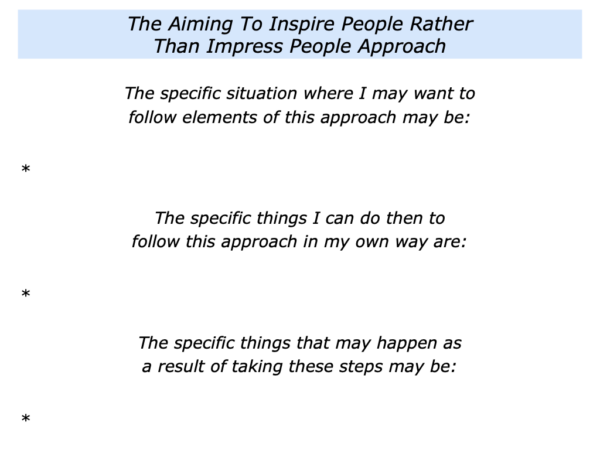
There are many ways to do fine work. One approach is to be humble and aim to inspire people rather than to impress people.
People who take this approach often aim to serve something greater than themselves. They may aim to follow a vocation, serve other people or pass on knowledge that can help other people to succeed.
Different people follow this approach in different ways. They may do it in their daily work or in specific situations. Let’s look at some examples.
Going For An Interview
Person A was preparing to attend an interview for a role in a famous football club. He called me before the session and described their approach to the interview. He expressed this in the following way.
“I want to really impress them. As you know, I have a good CV and also post a lot on social media. I want to stand out from the other candidates.”
This is a route taken by many people who apply for jobs. They focus on self-promotion and make the interview about them as an individual. The interviewers, however, are asking:
“What are you going to do for us? What are you going to help us to achieve success?”
After some discussion. Person A switched his approach and aimed to inspire the interviewers. He aimed:
To show he understood the club’s DNA – the principles it wanted to follow – and its picture of success;
To show how he would use his strengths to help the club to achieve success;
To show how he would pass on knowledge that would enable people in the club to achieve sustainable success.
The interview went well. He described what happened during the session in the following way.
“The session was more like a conversation. I started by describing what I saw as the Club’s DNA – its strengths and when it had performed at its best.
“I then described how I would like to help the club to follow these principles and deliver future success. This involved giving specific examples of how I would do this in practice.
“At this point the interviewers began asking questions. They wanted to know what I do would in specific situations. This was challenging but they seemed happy with the answers.
“This was when the interview turned into more of a conversation and I never got to finish my slide presentation. Two days later they called to say I had got the job.”
Such an approach is not guaranteed to work, of course, because different interviewers may be looking for different things. On this occasion it did succeed and led the Person A joining the club.
Giving A Keynote Speech
Person B was due to give a keynote speech to conference. She described her approach to this in the following way.
“I sometimes get nervous speaking to audiences in live situations. Maybe it is because I am an introvert, but I actually prefer to give presentations over the web.
“Even though I am sure of my subject, I can get distracted by focusing on the audience reactions. Maybe it is my desire to not to disappoint people, but I can get thrown off-course by the body language of some people.
“Giving the session virtually means I can concentrate on the key messages I want to give. This is preferable to trying to impress people when I am on stage.”
We explored how she could feel at ease when speaking to the conference audience. Bearing in mind her strengths, we aimed:
To clarify what was happening in the audience’s world – such as their challenges and goals;
To clarify the knowledge that she could share that would help people to succeed;
To clarify how she could share this knowledge in a way in which she would feel at ease.
She could share knowledge in ways that played to her strengths. She could also bring the ideas to life by giving lots of examples. It was about helping people to succeed. It was not about self-promotion.
She did the presentation and reported that: a) she felt comfortable sharing the ideas in this way; b) several sought her out afterwards to explore the ideas and ask if they could stay in touch.
There are many ways to do fine work. As described here, one approach is to follow the principle that:
It is about aiming to inspire other people, it is not about trying to impress. It is about them, it is not about you.
Let’s return to your own life and work. Looking ahead, can you think of a situation where you may want to try to inspire people? This could be in your personal or professional life.
You may want to do this when encouraging a person, writing an article, giving a presentation or in another situation. How can you follow this approach in your own way?
If you wish, try tackling the exercise on this theme. This invites you to complete the following sentences.







Leave a Reply